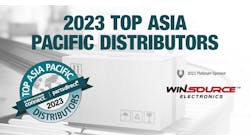It’s no secret that most electronics purchasers at small to mid-size OEMs and electronics manufacturing service providers buy most of the components their companies need for production from authorized distributors.
It’s also true that when parts are in short supply and can’t be purchased from authorized distributors, buyers turn to non-franchised independent distributors, which may have the parts in stock or know where they can be sourced. Some buyers also purchase from independent distributors because they can get a better price for a part, while others sell their excess inventory to independent distributors.
Independent distributors generally do not have franchise agreements with component manufacturers. There are some that have a few franchises with certain component manufacturers, however, and in recent years some of them have added even more authorized lines.
One distributor that has been especially aggressive in adding franchise lines is America II, based in St. Petersburg, Fla. America II, which has historically been an independent distributor, has been steadily signing franchise agreements with component manufacturers.
The company now has 55 such agreements in place. Most of the agreements are with relatively small component manufacturers, which have sales in the $15 million to $30 million range. However, Brian Ellison, president of America II, recently told me his company is negotiating with several major component manufacturers for franchise agreements.
“There are six manufacturers that are $500 million plus, two of which are $1 billion manufacturers that we are in contract negotiations with,” he said.
In addition America II has “direct” relationships with about 200 parts manufacturers and buys directly from those suppliers, although it has no formal franchise agreements with them.
“We’ve made the transition over the years from an independent to a blended or hybrid distributor,” said Ellison. But now America II does not want to be known as an independent or hybrid or blended. “Our message is, we are simply a distributor.”
He said the idea behind adding franchise agreements is to “have a broader product offering to our customers.” The distributor wants to increase business within certain market segments such as automotive and medical, and it needs to be franchised for more lines to grow sales in those segments.
He said that although America II plans to add more authorized lines, it will continue to service buyers looking for parts that are in short supply or who are looking for lower price parts.
“The reason for going down the franchise path is not to turn our backs on the things we are good at and got us to where we are today, but to have a broader offering for customers,” he said.
A broader offering could result in more sales to more customers and have a positive impact on annual revenue. Ellison said the sales of parts from franchise lines and for parts that America II buys under its direct relationships account for up to 40% in any quarter. That percentage will likely increase if the company signs agreements with large component manufacturers.
Although America II plans to add more franchises, buyers should not expect other independent distributor to follow suit. Some independents say franchise agreements limit the products that a distributor can offer to customers.
“Some of our competitors have decided to go the franchise route, but we want to maintain the flexibility to provide whatever kind of product that customer needs,” said Paul Romano, chief operating officer for Boston-based independent distributor Fusion Worldwide. “We want to remain as flexible as possible to support our customers.”
Besides limiting flexibility, franchise agreements require a considerable investment.
“It's easy for anyone to pick up one or two franchise lines,” said Ellison. “But America II has spent millions of dollars investing in this to get to this next level” of franchise agreements, he said.
Ellison added that there are only a few independent distributors that “have the wherewithal to put the infrastructure in place” that franchise agreements require.








